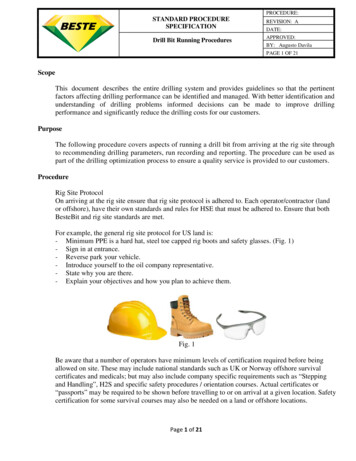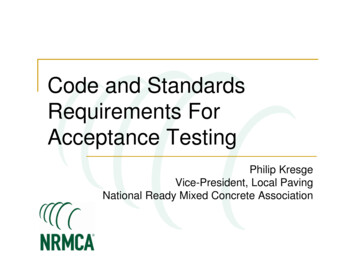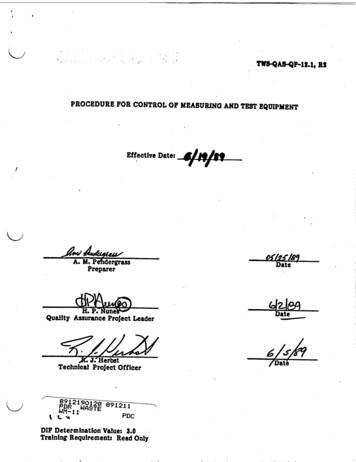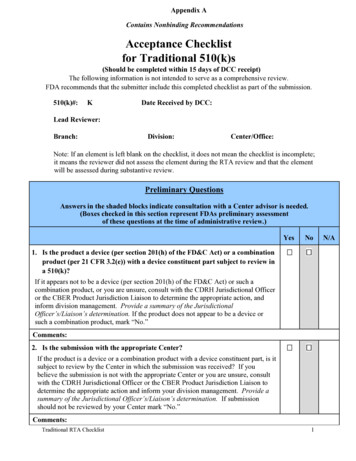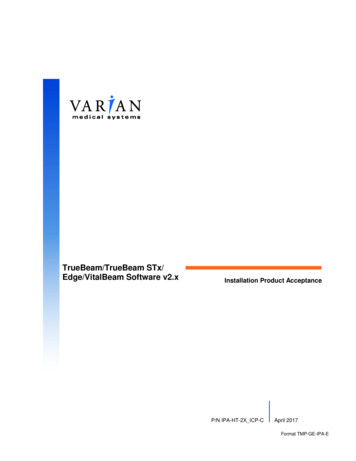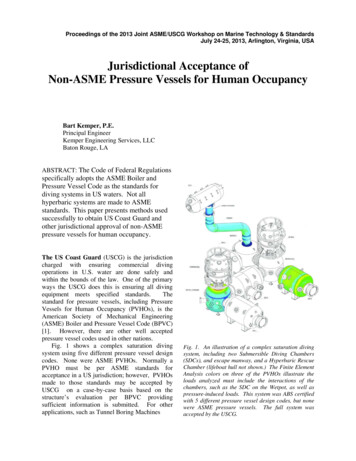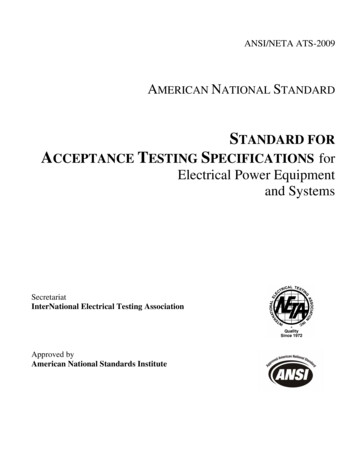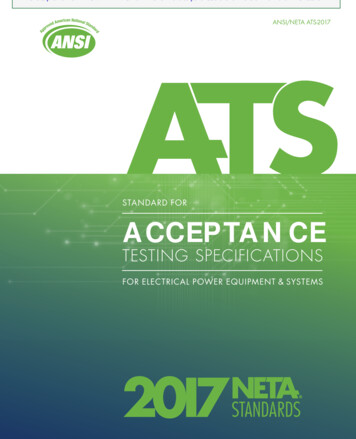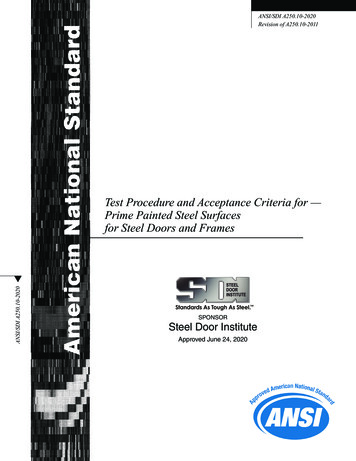
Transcription
ANSI/SDI A250.10-2020Revision of A250.10-2011ANSI/SDI A250.10-2020Test Procedure and Acceptance Criteria for —Prime Painted Steel Surfacesfor Steel Doors and FramesSPONSORSteel Door InstituteApproved June 24, 2020
This page left intentionally blank.
ANSI/SDI A250.10-2020American National StandardTest Procedure and Acceptance Criteria forPrime Painted Steel Surfacesfor Steel Doors and FramesSecretariatSteel Door InstituteApproved June 24, 2020American National Standards Institute, Inc.
This page left intentionally blank.
AmericanNationalStandardApproval of an American National Standard requires verification by ANSlthat the requirements for due process, consensus, and other criteria forapproval have been met by the standards developer.Consensus is established when, in the judgement of the ANSl Board ofStandards Review, substantial agreement has been reached by directlyand materially affected interests. Substantial agreement means much morethan a simple majority, but not necessarily unanimity. Consensus requiresthat all views and objections be considered, and that a concerted effort bemade toward their resolution.The use of American National Standards is completely voluntary; theirexistence does not in any respect preclude anyone, whether they have approved the standards or not, from manufacturing, marketing, purchasing, orusing products, processes, or procedures not conforming to the standards.The American National Standards Institute does not develop standards andwill in no circumstances give any interpretation of any American NationalStandard. Moreover, no person shall have the right or authority to issuean interpretation of an American National Standard in the name of theAmerican National Standards Institute. Requests for interpretations shouldbe addressed to the secretariat or sponsor whose name appears on thetitle page of this standard.CAUTION NOTICE: This American National Standard may be revised orwithdrawn at any time. The procedures of the American National StandardsInstitute require that action be taken periodically to reaffirm, revise, orwithdraw this standard. Purchasers of American National Standards mayreceive current information on all standards by calling or writing the American National Standards Institute.Published bySteel Door Institute30200 Detroit Road, Cleveland, Ohio 44145-1967Copyright 2020 by Steel Door InstituteAll rights reserved.No part of this publication may be reproduced in anyform, in an electronic retrieval system or otherwise,without prior written permission of the publisher.Printed in the United States of AmericaANSI/SDI A250.10-2020
ContentsPageForeword. . ii1General.11.1 Scope.11.2 Referenced Documents.12Material.13Testing. . .13.1 Salt Spray Testing. . .13.2 Condensation testing (humidity).23.3 Impact Test.23.4 Film adhesion test.24Acceptance criteria.24.1 Salt Spray resistance.24.2 Condensation resistance.24.3 Impact test. .24.4 Film Adhesion.25Report.26General.36.1 Test laboratory.36.2 Certification.3TablesTable 1 – Rust grades.2Table 2 – Classification of adhesive test results.6FiguresFigure 1 – Visual reference for percentage of rust.3Figure 2 – Blister size #2.4Figure 3 – Blister size #4.4Figure 4 – Blister size #6.5Figure 5 – Blister size #8.5i
Foreword(This Foreword is not part of American National Standard A250.10-2020)The material contained in this document has been developed under theauspices of the Technical Committee of the Steel Door Institute.The original standard was issued on July 28, 1980 and was revised in 1990and 1998. The 1998 edition was reaffirmed in 2004, and revised in 2011.The current edition is a revision of the 2011 document with the contentsbeing updated to reflect changes and advances that have take place in thesteel door and frame industry.Suggestions for improvement gained in the use of this standard are welcome and should be sent to the Steel Door Institute, 30200 Detroit Road,Cleveland, OH 44145-1967.The organizations that have approved this standard are as follows:Builders Hardware Manufacturers AssociationCanadian Steel Door Manufacturers Assoc.Cedar Valley AssociatesD. H. Pace CompanyDoor and Hardware InstituteDoor Control ServicesESTM Services, LLCHMMA/Division of NAAMMIntertekMasterSpecRay and AssociatesSteel Door InstituteUnderwriters Laboratories LLCVetrotech / Saint Gobainii
The Accredited Standards Committee A250 TC-1 developed this standardand had the following personnel at the time of approval:Craig Ordmandy, ChairmanJ. Jeffery Wherry, SecretaryOrganization RepresentedName of RepresentativeAllegion. Marilyn LathamBuilders Hardware Manufacturers Association. Mike TierneyCanadian Steel Door Manufacturers Assoc. Mike van GeynCeco Door ProductsAn ASSA ABLOY Door Group Company. Tom JanicakCedar Valley Associates. Stan HorsfallCurries CompanyAn ASSA ABLOY Door Group Company. David BillD.H. Pace Company. Jerry RiceDCI. Tom PopowDeansteel Manufacturing Company. Claus HeideDoor and Hardware Institute. Laura FryeDoor Control Services. Craig OrdmandyESTM Service, LLC. Mike KolovichHMMA/Division of NAAMM. Russell TauscherHollow Metal Xpress. Steve HoagIntertek. Dan JohnsonMasterSpec. Rick HowardMesker Door, Inc. Mike MehaffyMetal Products, Inc. David McConnellPioneer Industries, Inc.An ASSA ABLOY Door Group Company. Kamal SheikhPremier Steel Door & Frames. Joey MeggsRay & Associates. Ron RayRepublic. Steve GilliamSMPAn ASSA ABLOY Door Group Company. Kurt RoeperSteel Door Institute. J. J. WherryUnderwriters Laboratories LLC. Luke WoodsVetrotech Saint-Gobain. Kevin Norcrossiii
AMERICAN NATIONAL STANDARDANSI/SDI A250.10-2020American National StandardTest Procedure and Acceptance Criteria for —Prime Painted Steel Surfacesfor Steel Doors and Frames1General1.1 ScopeThese methods prescribe the procedures to be followed in the selection of material, chemical preparation of the steel substrate, prime paint coatingapplication, testing, and evaluation of prime painted steel surfaces for steel doors and frames.1.2 Referenced DocumentsASTM B117-16 Standard Practice for OperatingSalt Spray (Fog) ApparatusASTM D610-08 (2012) Standard Practice for Evaluating Degree of Rusting on Painted Steel SurfacesASTM D714-09 (2017) Standard Test Method forEvaluating Degree of Blistering of PaintsASTM D1654-08 (2016)e1 Standard Test Methodfor Evaluation of Painted or Coated SpecimensSubjected to Corrosive EnvironmentsASTM D2794-93 (2010) Standard Test Method forResistance of Organic Coatings to the Effects ofRapid Deformation (Impact)ASTM D3359-17 Standard Test Methods for Rating Adhesion by Tape TestASTM D4585 / D4585M-13 Standard Practice forTesting Water Resistance of Coatings Using Controlled Condensation2Material2.1 The test specimen shall be of the ASTM specification per ANSI/SDI A250.8 as used in the manufacturing of the products. Separate specimensshall be used for each test. The specimen shallbe a minimum 4″ (102mm) x 6″ (152mm) with a1/4″ (6.4mm) hole at the center of the 4″ (102mm)width, 1/2″ (12.7mm) in from the end. Identificationmarks shall be added to the specimen as requiredfor control purposes. The test specimen shall behandled at all stages of the process with cleangloves to prevent contamination.2.2 The specimen(s) shall be hung using a method representative of that used in production.2.3 The specimen(s) shall be cleaned, pre-treatedand prime painted in accordance with the manufacturer’s normal production method and procedure.All dry fill thickness used on test specimens shallbe documented and representative of the individual manufacturer’s normal production material.2.4 At the end of the coating cycle, the specimen(s)shall be removed from the system in such a manner as to avoid any contact with the primed surface by any other object. The primed surface of thespecimen shall not be handled or come in contactwith other objects in such a way as to disrupt theprimed surface.2.5 All specimens shall be allowed to age at ambient room temperature, for a minimum 72 hour duration before any testing commences.3 Testing3.1 Salt Spray Testinga) Apparatus – The apparatus used for salt spraytesting shall be of such design as to conform toASTM B117.b) Test performance – Salt spray testing shall beconducted as specified in ASTM B117 for atest period of 120 continuous hours. The testspecimen(s) shall be scribed with an “X” perASTM D1654, sections 4.1 and 5.1.1
ANSI/SDI A250.10-2020Table 1 – Rust grades3.2 Condensation testing (humidity)a) Apparatus – The apparatus used for condensation (humidity) testing shall be of such design as to conform to ASTM D4585.b) Test performance – Condensation (humidity) testing shall be conducted as specified inASTM D4585 for a test period of 240 continuous hours. Exposure temperatures shall bemaintained at a minimum of 100 Fahrenheit(380 C). Actual test temperature shall be notedin the report.3.3 Impact TestThe prime paint coating shall be subject to oneimpact per ASTM D2794 with 20 inch pounds ofdirect impact using a Gardner Impact Tester with a1/2″ (12.7 mm) diameter ball or punch at room temperature of 70 – 75 Fahrenheit. Apply one-inch(25.4 mm) wide #600 Scotch cellophane pressuresensitive tape firmly to the impact area and pull offsharply.Note: In order to ensure adhesion, #600 Scotchcellophane pressure sensitive tape must be storedand used within shelf life, as recommended by themanufacturer.3.4 Film adhesion testThe prime coating film adhesion shall be tested inaccordance with method “B” of ASTM D3359.A total of (11) parallel cuts are made with a sharpinstrument, 0.039″ (1 mm) apart in both a verticaland horizontal direction, forming a grid.One-inch (25.4 mm) wide pressure-sensitive tapeis then firmly applied to the scribed surface andpulled off sharply.Note: In order to ensure adhesion #600 Scotchcellophane pressure sensitive tape must be storedand used within shelf life, as recommended by themanufacturer.4 Acceptance criteria4.1 Salt Spray resistanceApplied prime paint on the unscored surface of thetest specimen shall have a rust grade of no lessthan 6 as defined in ASTM D610.Table 1 and the depictions shown in Figure 1 illustrate the scale used to evaluate the rust grades.The painting film at the scribe line shall not be undercut by rust more than 1/8″ (3.2 mm) each side,2RustGradeMaximum %of rusted .00233.00150.000100.00when tested in accordance with paragraph 3.1(or a Rating Number 6 on each side of the scribeline, when evaluated and rated in accordance withASTM D1654, Table 1. “Rating of Failure at Scribe(Procedure A).”)4.2 Condensation resistanceApplied prime paint
ASTM D3359-17 Standard Test Methods for Rat-ing Adhesion by Tape Test ASTM D4585 / D4585M-13 Standard Practice for Testing Water Resistance of Coatings Using Con-trolled Condensation 2 Material 2.1 The test specimen shall be of the ASTM speci-fication per ANSI/SDI A250.8 as used in the man-ufacturing of the products. Separate specimens shall be used for each test. The specimen shall be a .

